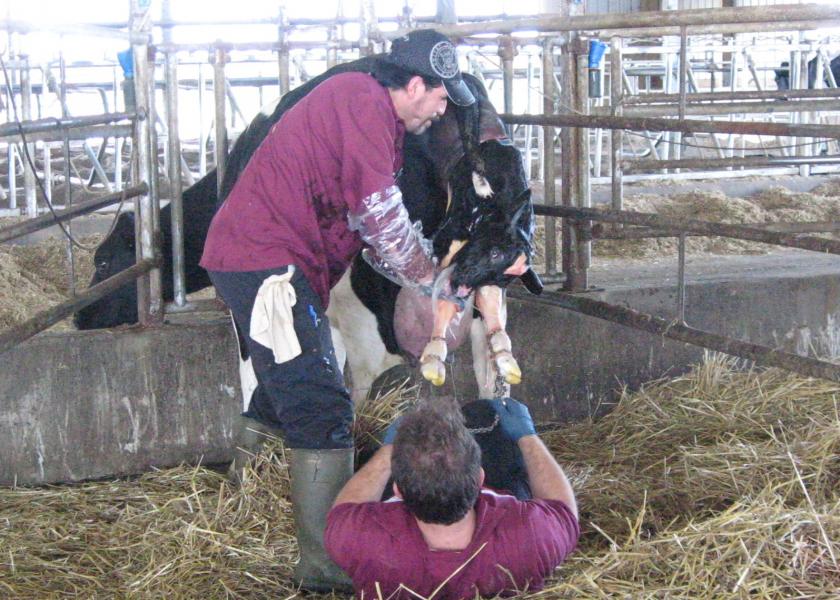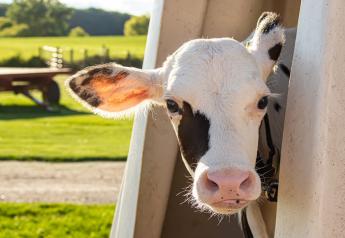Hard Calvings Mean a Difficult Start in Life for Calves

Calves experiencing a traumatic birth have the decked stacked against them as they adapt to life outside the womb. In his Calving Ease Newsletter, New York calf and heifer specialist Sam Leadley says one study that followed more than 7,500 dairy calves (Lombard et al.) for their first 120 days of life showed that calves with the most challenging births (born via surgical procedure) were over 6 times more likely to die compared to calves that required little to no assistance at birth.
The calves with the most difficult births also were 1.3 times more likely to experience scours and 1.6 times more likely to suffer from respiratory disease, compared to the calves requiring little to no help. In another study (Wells), heifer calves born via forced extraction were more than 4 times more likely to die within the first 21 days of life, compared to calves requiring no birthing assistance.
Leadley said Holsteins are more likely to experience difficult calvings (dystocia) than Jerseys, and that first-calf heifers require more assistance (19%) than higher-parity dams (11%). For first-calf heifers, dystocia usually is caused by fetal-maternal size mismatch, while fetal malpresentation or maternal-related causes generally lead to dystocia in older cows.
Calves born requiring any kind of assistance should automatically be considered “at-risk,” even if they appear healthy, according to Colorado State University Professor of Veterinary Medicine Franklyn Garry. He said calves born to dystocia are likely to have hypothermia; low blood oxygen (hypoxemia); metabolic and/or respiratory acidosis; and impaired ability to absorb colostral antibodies, resulting in failure of passive transfer of immunity.
Garry said dystocia calves are typically less active and have diminished cardio-respiratory function compared to calves born naturally. This impacts a number of body systems and subsequent immune function. But these calves can be assisted by:
- Promoting breathing – Clean straw poked in the nostril, ice water on the head, and rolling calves onto their stomachs all can help calves clear their lungs and assume normal respiration after a difficult birth.
- Warming and stimulating – Chilled calves breathe poorly and need to expend energy reserves to regulate their body temperature, which sets them back further. Use clean, dry towels to vigorously dry and rub the calf. Some dairies also use hair dryers to dry and fluff the hair coat. (See Leadley’s advice on how to dry calves). Deep, clean, dry bedding and moving calves out of drafts also are advised; warming boxes are not recommended.
- Delivering colostrum – Feed calves clean, high-quality colostrum as soon as possible after birth. For Holstein calves, the recommended dose volume is 4 quarts. Most dystocia calves will not readily suckle a bottle, so colostrum delivery via esophageal feeder often is necessary. Calves with poor respiratory function and oxygen delivery to tissues also absorb colostral antibodies less efficiently, but the upside is they appear to be capable of absorbing them longer than normal. So it is worth providing extra colostrum feedings in the first few days of life. In addition to antibodies, colostrum is an excellent source of nutrients, hydration and warmth to these stressed calves.
- Treating acidosis – Most dystocia calves have a higher-than-average level of metabolic and respiratory acidosis. Those that appear weak, depressed and lethargic should be administered IV fluids, either by trained on-farm personnel, or a veterinarian.
In the bigger picture, Garry said herds should try to minimize dystocia births by:
- Working with the herd veterinarian to train all on-farm personnel on calving stages; recognizing problems; and knowing when and how to assist.
- Selecting calving-ease sires for both first-calf heifers and cows.
- Documenting every birth and assigning a calving score (see a scoring system here) to build a herd database that can be used to evaluate breeding and calving management over time.







